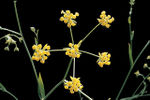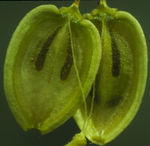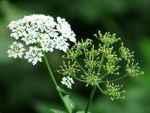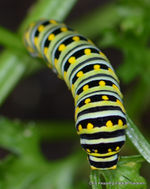Apiaceae
| Apiaceae |
|---|
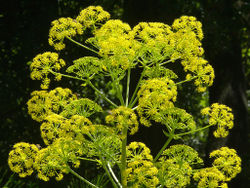
|
| Scientific Classification |
|
| Genera |
|
The plant taxonomic family Apiaceae (or Umbelliferae) contains about 300 genera and 2500 to 3000 species. this group contains mostly herbaceous plants with taproots. [3] They can be annual, perennial, or biennial. The most distinctive characteristic are their compound umbel florescences that contain many small flowers. Members of Apiaceae reproduce sexually and produce seeds. Many species have culinary uses, but others can be very poisonous, causing rashes and skin irritation.
Body Design
Most plants in this group have soft, herbaceous, hollow stems. A few shrub-like species possess woody stems. [4] The stems usually contain tubes of scented oils. [5] This, along with their aromatic seeds, is the reason that plants such as coriander, parsley, and fennel are used for culinary purposes. [6] Leaves of Apiaceae plants can vary from the base of the stem to the top, so the middle leaves are usually used in identification.[7] In general these leaves or leaf groups will be arranged alternately along the stem. [5] The leaves are rarely simple (one leaf blade on one petiole) and are most often compound (several blades on a single petiole) or significantly dissected. [7] They can be pinnately or palmately compound (leaflets along the midrib or several leaflets extending from a single point).[5] The petiole is sheathing (wrapping around the stem).[3] The plant's roots are taproot, as seen in the carrot or parsnip. [6]
The most telltale characteristic of this family is the umbel flower structures. Each tiny flower has five petals but may have no sepals. [7] It has five stamens and one compound pistil formed by two carpels, two styles, and one inferior ovary that has two locules. [8] The flowers are very uniform throughout the plant, but some species have varying flowers (such as those with bilateral symmetry) around the outer edge of the umbel that causes the structure to look like one large flower. [3] In a few genera the umbels are simple. However, in most they are compound. The primary branches, called rays, each hold a smaller umbellet of flowers. [7] All of the rays must radiate from a single point to be classified as a true umbel structure. [9]
Life Cycle
Due to the numerous genera and species in Apiaceae, life cycles can vary. The majority are annual or perennial. [5] However, they can also be biennial. Because most are herbaceous, they can be fast growing. [6] Those that are perennial can bloom multiple times and some develop bulbs underground. [10]
The level of maturity can vary throughout the plant. That is, each umbel in a plant can be at a different stage of the growing or reproduction cycle. [7]The plants are usually hermaphroditic, with the umbels containing both male and female flowers. [5] The ratio of male to female flowers in various umbels on one plant varies between species. It can even vary by the level of umbel on the plant. [11] Some species have flowers that are pseudanthial. This phenomenon is associated with sterile flowers around the periphery of a group of flowers. Thus, these cannot be pollinated and are simply used to attract pollinators. Members of Apiaceae have pollination that is entomophilous (pollination by insects rather than wind, water, etc.). [5]
Many members of Apiaceae exhibit Temporal dioecism, a type of life cycle in which there is little overlap of the pistillate and staminate phases. [12] Pollen is produced when the pistil are not mature, and thus limits the amount of self-pollination possible, instead having its pollen carried to other plants. [11] Once pollinated, the flowers produce schizocarps, tough, dry fruits. In most, this schizocarp splits into two mericarps. Each mericarp contains one seed. [13]
Ecology
Members of Apiaceae grow across the world. [3] They are mostly found in temperate areas, but a few species live in tropical regions.[5] The plants prefer areas with low moisture stress and sunny conditions. [6] They thrive in habitats such as wetlands, forests, and fields.[5] They can spread quickly and, therefor, are good agricultural plants. This also makes some of them invasive species. They can spread from agricultural sights into native flora and become a weed. Carrots, or Queen Anne’s Lace, and fennel have become weeds in certain areas due to this ability. [6] Goutweed can also spread very quickly, but this can be somewhat beneficial due to the fact that it indicates nitrogen rich soil. [14]
Members of this family have unique relationships with insects. Due to their large umbels, larger insects can land on and pollinate them. These large insects also consume the smaller, herbivorous insects that feed on the plant. They can also attract certain insects using nectar from their large stylopodium. Some even produce strong scents that hide the pheromones of some insects, deterring them from the plants. The ability to deter harmful insects while attracting helpful ones can benefit other plants around the members of Apiaceae, and so they are often used as companion plants to other crops. [5] Certain plants of Apiaceae support some of the swallowtail butterfly species. Papilio polyxenes prefers celery species, while Eastern Black Swallowtails and Anise Swallowtails prefer parsley and carrot varieties. [14] The butterflies lay their eggs on the plants of Apiaceae, and the larva use them as host plants while they mature. They use species in the genera of Cicuta, Carum, Apium (Celery), and many more. They are able to live on and even consume the poisonous hemlock species, as they have the remarkable ability to detoxify the poison in the plant. [15]
Helpful and Harmful Species
Apiaceae has many species that have agricultural uses. Some, like carrots (Daucus) and parsnip (Heracleum), are harvested for their taproots. Others, like celery (Apium), are grown for their stems. Fennel (Foeniculum), dill (Anethum), cumin (Cuminum) parsley (Petroselinum), cilantro (Coriandrum), and coriander (Coriandrum) are other common spices and flavorings for food.
A medicinal use of osha, a plant in the genus Ligusticum, is used to clear the mind. Gotu Cola (Centalla asiatica) also has this ability. Parsley seed tea is said to help alcoholism. Angelica has been used to treat colds and flues. [14] However, angelica can also cause dermatitis in sensitive people. [7]
Although most people blame stinging nettles, poison ivy, or insects usually for a skin rash after a venture into the woods, wild parsnip can be just as common and painful. Wild parsnip can cause a condition known as “phyto-photo-dermatitis.” Chemicals (furocoumarins) in the juices of the stem and leaves can be absorbed into the skin. Ultraviolet light from sunlight can energize this toxin, causing it to bind with cell membranes and even nuclear DNA. This creates and a burning, blistering rash on the affected area. Perspiration can exacerbate the problem by spreading the chemicals. The rash usually appears the day after contact and can last for a day or two. While not as irritating as poison ivy, it does not require sensitizing by prior exposure to affect a person. [16] Giant Hogweed can also cause photodermatitis. [13]
Species in the genera Conium, Cicuta, and Aethusa, notably Poison Hemlock, Water Hemlock, and Cow Parsley, are highly poisonous. [14] Poison Hemlock has a distinctive purple-spotted stem, but its white flowered umbels look similar to other species in Apiaceae. In the 1980s, three campers died from eating Poison Hemlock which they mistook for Queen Anne’s Lace (carrot). Both are white-flowered umbellifers. [3] There have also been cases where children have been poisoned when using its hollow stem for straws. [9]
Video
An overview of Apiaceae and notable species.
Gallery
References
- ↑ Classification for Kingdom Plantae Down to Family Apiaceae United States Department of Agriculture. Web. Accessed 12 May 2013.
- ↑ Apiaceae Wikispeices. Web. Accessed 1 June 2013.
- ↑ 3.0 3.1 3.2 3.3 3.4 Apiaceae Utah State University. Web. Accessed 19 May 2013.
- ↑ APIACEAE (formerly UMBELLIFERAE) - The Celery Family The Seed Site. Web. Accessed 19 May 2013.
- ↑ 5.0 5.1 5.2 5.3 5.4 5.5 5.6 5.7 5.8 Muñiz, Mary C. Biotic Inventory: Documenting Diverstiy at the Katharine Ordway Natural History Study Area Macalester College. Web. Published 15 April 2010.
- ↑ 6.0 6.1 6.2 6.3 6.4 Apiaceae (Umbelliferae) North Coast Native Nursery. Web. Accessed 19 May 2013.
- ↑ 7.0 7.1 7.2 7.3 7.4 7.5 Reznicek, A. A., Voss, E. G., & Walters, B. S. Apiaceae Herbarium University of Michigan. Web. Published February 2011.
- ↑ Apiaceae (Umbelliferae) University of Hawaii at Manoa Botany. Web. Accessed 19 May 2013.
- ↑ 9.0 9.1 Elpel, Thomas J. Apiaceae Carrot or Parsley Family Wildflowers-and-Weeds. Web. Accessed 19 May 2013.
- ↑ Bulbing Fennel Life Cycle National Gardening Association. Web. Accessed 27 May 2013.
- ↑ 11.0 11.1 Lovett Doust, J. Floral Sex Ratios in Andromonoecious Umbelliferae Wiley Online Library . Web. Published 16 September 1979.
- ↑ Malono-Flores, Brenda. Reproductive biology of Eryngium yuccifolium (Apiaceae), a prairie species Pollinator Conservation Digital Library. Web. Accessed 27 May 2013.
- ↑ 13.0 13.1 Apiaceae (Parsley Family) OhioPlants.org. Web. Accessed 27 May 2013.
- ↑ 14.0 14.1 14.2 14.3 Williams, Marc. Apiaceae Botany Every Day. Web. Published 7 June 2011.
- ↑ Hall, Donald. Eastern Black Swallowtail: Papilio polyxenes asterius (Stoll) (Insecta: Lepidoptera: Papilionidae)1' EDIS. Web. Accessed 27 May 2013.
- ↑ Eagan, David J. Burned by wild parsnip Wisconsin Natural Resources Magazine. Web. Published June 1999.
